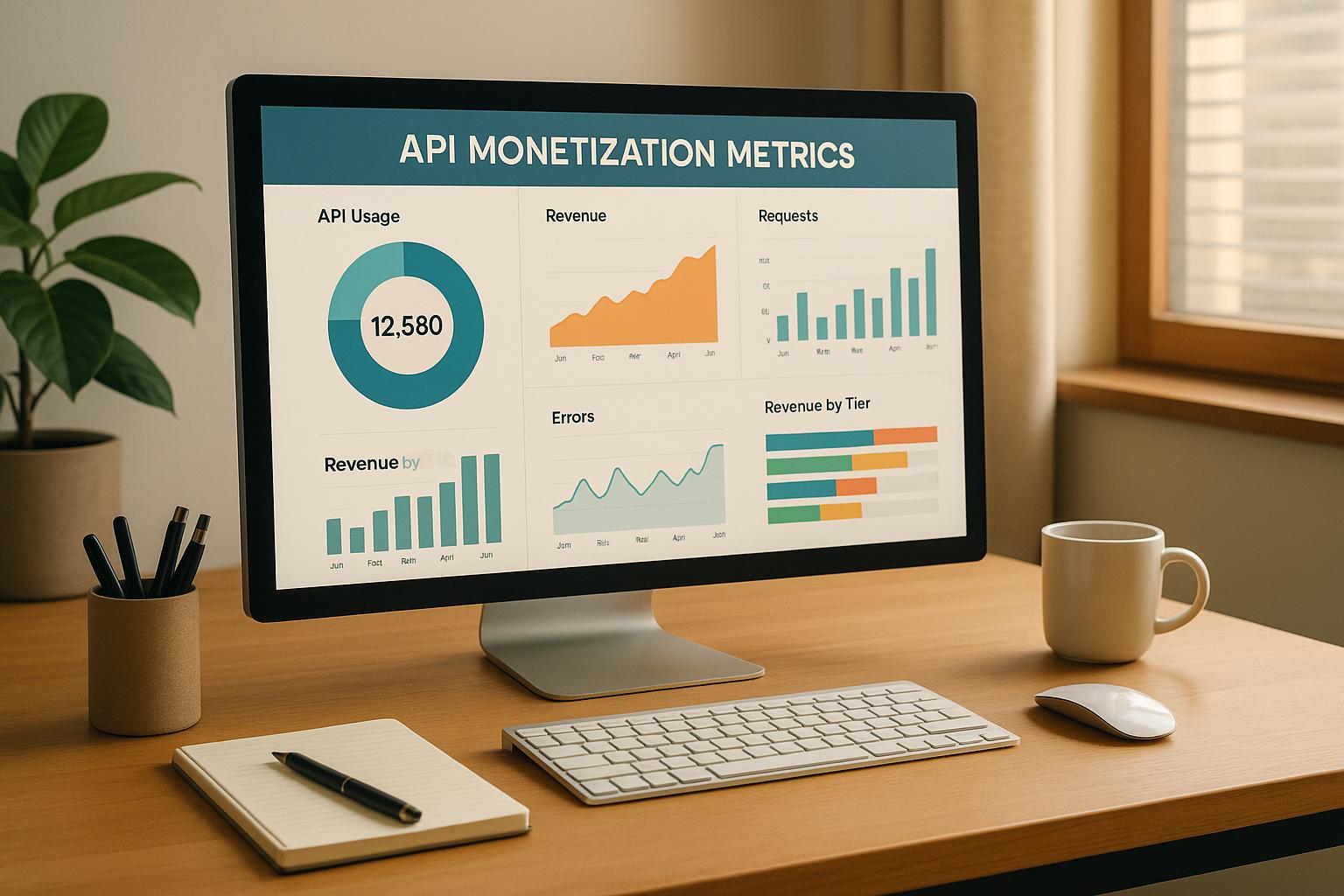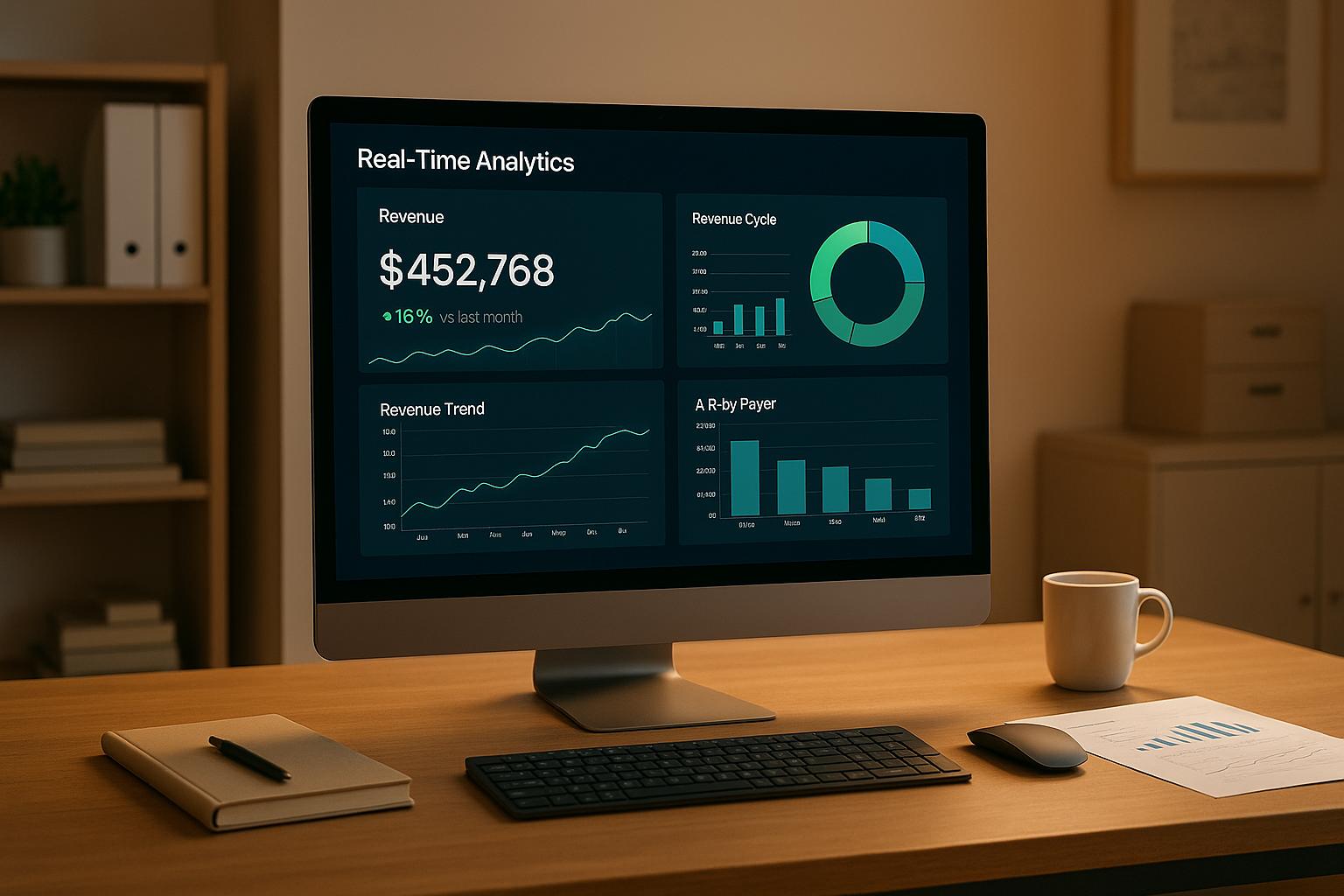Top Metrics for API Monetization Success

APIs are no longer just technical tools - they’re revenue drivers. In 2023, 43% of companies reported APIs contributing over 25% of their revenue. To monetize APIs effectively, businesses must track key metrics that reveal customer behavior, usage patterns, and financial performance. Here’s a quick breakdown of the most important metrics for API monetization:
-
Financial Metrics:
- MRR (Monthly Recurring Revenue): Tracks consistent monthly income from subscriptions.
- ARPU (Average Revenue Per User): Measures revenue per customer to identify profitable segments.
- CLV (Customer Lifetime Value): Estimates total revenue from a customer over time, helping with acquisition and retention strategies.
-
Usage Metrics:
- API Usage Count: Monitors endpoint calls to understand demand and user engagement.
- CAC (Customer Acquisition Cost): Calculates the cost of acquiring new customers, ensuring growth is financially viable.
- CLR (Customer Loss Rate): Tracks churn, helping businesses focus on retention.
-
Performance Metrics:
- API Speed/Latency: Ensures fast response times for better user experience.
- Error Rates: Tracks failed requests to maintain reliability and trust.
Financial Metrics for API Revenue Tracking
When it comes to monetizing APIs, financial metrics are your compass. They provide insight into how well your API generates income, maintains financial stability, and supports growth. For businesses treating APIs as profit centers, tracking the right numbers is essential for crafting effective strategies. Let’s dive into three critical metrics that shape API revenue performance: MRR, ARPU, and CLV.
Monthly Recurring Revenue (MRR)
Monthly Recurring Revenue (MRR) is the heartbeat of subscription-based APIs. It tracks the consistent income your API brings in each month from subscriptions and recurring usage fees. This metric is crucial because it smooths out the unpredictability of one-time payments, offering a clearer picture of financial health and stability.
To calculate MRR, sum up all recurring subscription fees and average any usage-based charges over a defined period (usually three to six months to account for seasonal fluctuations). Exclude one-off payments or setup fees to keep the focus on recurring revenue streams. A steady or growing MRR indicates a strong foundation for forecasting and planning future investments.
Average Revenue Per User (ARPU)
ARPU, or Average Revenue Per User, tells you how much revenue each customer contributes on average. It’s a straightforward way to identify your most profitable customer segments and refine your pricing strategies.
To calculate ARPU, divide your total API revenue by the number of active users during a specific period. Digging deeper - segmenting ARPU by customer type, usage, or pricing tiers - can uncover valuable insights. For example, enterprise clients often generate higher ARPU compared to smaller customers. This information can help you tailor offerings to maximize revenue from high-value segments.
Customer Lifetime Value (CLV)
Customer Lifetime Value (CLV) estimates the total revenue a customer will generate over their relationship with your API. This metric is a game-changer for understanding the long-term value of your customer base and making smart decisions about acquisition and retention spending.
CLV is calculated by multiplying a customer’s average monthly revenue by their gross margin and expected lifespan. Knowing your CLV is especially important in the API world, where acquiring customers can be costly. It helps justify investments in marketing, sales, and customer success initiatives.
For context, a healthy CLV-to-CAC (Customer Acquisition Cost) ratio is often around 3:1 - meaning the revenue from a customer should be about three times the cost of acquiring them. Regularly monitoring CLV can reveal shifts in customer behavior, and even small improvements in retention can significantly boost overall CLV. This underscores the importance of prioritizing customer success.
API Usage and Customer Metrics
Understanding customer interaction and acquisition costs is key to building a profitable API business. By carefully analyzing usage patterns and customer metrics, you can refine your monetization strategies and make informed business decisions.
API Usage Count
API usage count tracks how often your API endpoints are called. This metric is a window into customer behavior, product-market alignment, and revenue potential.
By monitoring usage patterns, you can pinpoint high-demand times, identify popular features, spot scaling issues, and detect early signs of customer disengagement. These insights help shape pricing strategies, distinguishing heavy enterprise users from light freemium users.
Usage data also acts as a health check for customer relationships. For instance, a noticeable drop in API calls from a high-value customer might signal technical troubles, changing priorities, or even churn risk. On the other hand, consistent growth in usage often reflects customer satisfaction and potential for upselling.
To make the most of this data, segment it by customer type, pricing tier, and time period. This detailed view helps you allocate resources wisely, plan infrastructure upgrades, and identify which customer groups deliver the most value per API call.
Once you’ve analyzed usage, it’s time to dive into the cost of acquiring these customers.
Customer Acquisition Cost (CAC)
Customer Acquisition Cost (CAC) measures how much you spend to bring in each new API customer. It’s a key metric for assessing whether your growth strategy is financially viable.
To calculate CAC, divide your total sales and marketing expenses by the number of new customers acquired during a specific timeframe. Be sure to include onboarding, customer success efforts, and promotional discounts to get a complete picture of acquisition costs.
The real insight comes when you compare CAC to Customer Lifetime Value (LTV). A healthy LTV:CAC ratio is around 3:1 - meaning each customer should generate three times the revenue it costs to acquire them. If your ratio falls short, you’re either overspending on acquisition or not generating enough value from customers over time.
Smart businesses break down CAC by customer type, acquisition channel, and market segment. For example, enterprise customers often have higher acquisition costs but bring in much more revenue, while self-service customers may cost less to acquire but require different retention strategies. Understanding these differences helps you allocate your marketing budget more effectively and focus on the most profitable customer groups.
While keeping acquisition costs in check is important, retaining customers is just as critical.
Customer Loss Rate (CLR)
Customer Loss Rate (CLR), or churn rate, measures the percentage of customers who stop using your API within a given period. In the API world, where switching costs are often low, keeping a close eye on churn is essential for long-term success.
To calculate CLR, divide the number of customers lost by the total number of customers at the start of the period. But not all churn has the same impact. Segment your churn data by customer value, usage habits, and subscription tier to understand which losses hurt the most.
For example, losing a high-value customer is far more concerning than losing a free-tier user who barely engaged with your API. Focus your retention efforts on the areas that will have the greatest financial impact. Look for early warning signs of churn, such as declining API usage, frequent support tickets, or delayed payments, to intervene before customers leave.
Even small reductions in churn can significantly boost profitability. Retaining customers is typically far less expensive than acquiring new ones, and in the API business, customer relationships often grow stronger over time as integrations deepen and become more critical.
When combined, these three metrics - API usage count, CAC, and CLR - create a powerful framework for API monetization. High usage paired with low churn signals strong product-market alignment, while efficient CAC spending ensures sustainable growth. Together, they provide the insights you need to refine pricing, elevate the customer experience, and build a thriving API business.
API Performance and Reliability Metrics
When it comes to successful API monetization, performance and reliability are non-negotiable. An API that consistently delivers fast, error-free responses becomes a trusted part of a customer’s system, strengthening retention and loyalty. On the flip side, sluggish performance or frequent errors can erode trust, pushing customers to seek alternatives. Keeping a close eye on performance metrics is not just about technical excellence - it’s about retaining customers and maximizing revenue.
API Speed and Latency
In real-time applications, low latency - measured in milliseconds - is everything. Fast response times ensure smooth user experiences and make APIs more appealing for high-demand integrations. Monitoring peak usage periods is crucial, as it can highlight infrastructure weaknesses that need attention.
Geography also plays a role in API speed. Users located far from your primary servers may notice slower responses. Solutions like Content Delivery Networks (CDNs) or regional gateways can bridge this gap, ensuring that users worldwide enjoy consistent performance. By keeping latency low, you not only enhance customer satisfaction but also pave the way for increased usage and growth.
Error Rates and Failed Requests
Error rates are a direct reflection of an API’s reliability. They measure the percentage of requests that fail to return a successful response. Tracking HTTP status codes helps pinpoint the source of these issues:
- 4xx errors often stem from client-side issues, such as invalid authentication or poorly formatted requests.
- 5xx errors indicate server-side problems, which can undermine your API’s reliability and customer trust.
Minimizing these errors is a top priority for API providers. For instance, frequent authentication errors might signal challenges in the onboarding process, while timeout or rate-limiting issues could point to infrastructure or scaling limitations.
An error budget can be a helpful tool for balancing innovation with reliability. By setting an acceptable threshold for errors, teams can focus on system stability without completely halting new feature rollouts. Breaking down error data by customer tiers or usage patterns can also uncover trends - like whether premium users encounter fewer issues than free-tier users. Real-time monitoring and alert systems ensure that spikes in errors are addressed quickly, reducing the risk of customer churn.
When combined, fast response times and minimal error rates paint a clear picture of API health. These metrics are not just technical benchmarks - they’re the foundation for building trust, supporting customer retention, and shaping effective monetization strategies.
sbb-itb-e766981
API Monetization Strategy and Pricing
A solid API pricing strategy is key to successful monetization. The best API businesses know that pricing goes beyond just covering costs - it’s about reflecting the value you bring to customers while encouraging adoption and growth. Your pricing model influences critical metrics like customer acquisition costs and lifetime value.
Tiered and Value-Based Pricing Models
Tiered pricing is one of the most effective methods for API monetization. It gives customers clear upgrade paths, starting with a free or low-cost tier to drive adoption and scaling up based on usage, features, or both. The key is to align tiers with distinct customer segments and their willingness to pay.
But don’t just price based on API calls - consider the business value your API delivers. For example, a payment processing API could charge based on transaction volume rather than the number of API requests since higher-value transactions generate more revenue for users.
A hybrid model combines usage-based pricing with feature differentiation, allowing you to capture value from both high-volume users and those seeking specialized features. Lower tiers might focus on call volume limits, while premium tiers unlock advanced features like priority support, enhanced security, or access to premium data.
Rate limiting plays an important role in making tiered pricing work. By setting clear limits for each tier, you create natural incentives for users to upgrade without causing frustration. The goal is to make the decision to upgrade feel logical and beneficial when users hit their limits - not like a penalty.
For more complex pricing structures and adjustments, seeking expert financial advice can make a big difference.
Working with Financial Experts
Given the complexities of API pricing, collaborating with financial experts can help refine your strategy. Monetization success depends on solid financial planning, and many API companies struggle with pricing because they lack the tools to analyze unit economics, forecast revenue, or test different pricing models effectively.
Phoenix Strategy Group specializes in guiding growth-stage companies through these challenges. Their fractional CFO and FP&A services help API businesses understand key financial metrics and optimize pricing strategies. They offer services like revenue analysis, cash flow forecasting, and KPI development to build a strong financial foundation for monetization.
Phoenix Strategy Group’s data engineering capabilities are particularly valuable when tracking multiple monetization metrics. Real-time financial data synchronization ensures that pricing decisions are informed and accurate.
If you’re preparing for growth or fundraising, Phoenix Strategy Group’s M&A and fundraising support can position your pricing strategy as a competitive advantage. Investors look for clear paths to profitability and scalable revenue models - exactly what a smart API pricing strategy delivers.
Their Monday Morning Metrics approach keeps stakeholders informed about monetization performance without overwhelming them with unnecessary data. This regular reporting helps API companies quickly adjust pricing or promotional strategies based on real-world feedback.
Partnering with financial experts can also help you avoid common pitfalls, like undervaluing your API or setting up tier structures that stifle growth. Professional guidance ensures your pricing strategy aligns with long-term business goals while supporting sustainable revenue growth.
Conclusion: Tracking Metrics for API Monetization Success
Turning your API into a revenue generator requires a solid, data-driven strategy that keeps a close eye on financial, usage, and operational performance. The metrics we've discussed - like monthly recurring revenue (MRR), customer lifetime value (CLV), API performance, and pricing models - are key components of any successful monetization plan.
These metrics don’t work in isolation. Together, they shape smarter pricing strategies and improve customer retention. For example, understanding customer acquisition costs (CAC), average revenue per user (ARPU), and usage patterns can help fine-tune pricing while keeping customers engaged. Without regular tracking and analysis, even the most promising APIs can fall short of their potential.
Real-time monitoring is especially important as your API scales. Small performance quirks that go unnoticed at 1,000 calls can erode trust at 100,000 calls. Additionally, pricing models may need adjustments to accommodate the needs of larger, enterprise clients.
Managing all these metrics can feel overwhelming, especially for growing API businesses. This is where expert support, like the services offered by Phoenix Strategy Group, can make a difference. Their fractional CFO and data engineering solutions help businesses set up reliable tracking systems and connect key metrics to long-term goals.
Tracking metrics isn’t a one-and-done task - it’s a continuous process. As markets shift, customer expectations change, and competitors evolve, your approach must adapt too. The API companies that succeed are the ones that consistently use their data to refine their strategies. Whether you’re just starting to monetize your API or looking to maximize an established revenue stream, focusing on these critical metrics will give you the insights you need to build a profitable and sustainable business.
FAQs
What are the best strategies for pricing APIs to attract new customers while keeping existing ones loyal?
To find the sweet spot in API pricing, businesses should explore tiered pricing models tailored to different customer needs. By offering multiple plans - like basic, premium, and enterprise tiers - customers can pick options that fit their budget and requirements. This structure not only makes APIs accessible with affordable entry-level plans but also provides advanced features for those willing to pay more.
Another smart approach is usage-based pricing, where customers are charged based on how much they use the API. This model is appealing because it ensures users only pay for what they consume, making it a great fit for both smaller users and larger-scale operations. Blending these pricing strategies can help attract new customers with competitive options while keeping current users satisfied by aligning costs with the value they receive.
What are effective ways to reduce customer churn in API-driven businesses?
Reducing customer churn in API-driven businesses starts with making onboarding seamless. The quicker users grasp your service and see its value, the more likely they are to stick around. Clear instructions and an intuitive setup process can make all the difference. Pair this with tailored support that proactively addresses individual customer needs, and you’ll strengthen trust and build lasting relationships.
Another effective approach is using data analytics to spot customers who might be at risk. By keeping an eye on usage trends and engagement levels, you can step in and resolve issues before they escalate. Additionally, keeping your API fresh with regular updates, maintaining open communication, and offering perks can nurture loyalty and keep users engaged for the long haul.
What role do financial, usage, and performance metrics play in building a successful API monetization strategy?
Financial, usage, and performance metrics come together to paint a complete picture of how successful your API monetization efforts are. Financial metrics like Monthly Recurring Revenue (MRR), Customer Lifetime Value (CLV), and Average Revenue Per User (ARPU) provide a clear snapshot of revenue patterns and overall profitability.
On the other hand, usage data - such as API request rates and customer activity trends - offers valuable insight into demand and user engagement.
Equally important are performance metrics, which measure factors like response times, latency, and uptime. These ensure your API consistently delivers a smooth and reliable experience for users.
By analyzing these metrics together, businesses can refine their pricing strategies, identify customer segments more effectively, and maintain top-notch API performance. This balanced approach not only strengthens user satisfaction but also supports steady growth and revenue.




